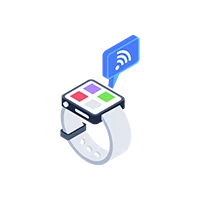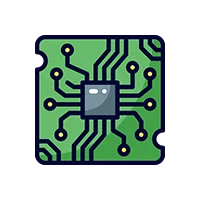Ultra-Fast Connectivity
The new era of connectivity is here and that is 6G. 6G internet connectivity will revolutionize the internet and digital trends. The digital world will further bring digital innovation promising not just faster internet, but it will speed up everything present on digital platforms. This will not only open new doors for business innovation, facilitating the new AI technology, IoT, enabling instant communication, and many more.
5G is considered a stepping stone towards fast and smooth internet speed, however, 6G will start a new era of linking everything. According to McKinsey 6G will transform connectivity and has the potential to bring innovations, expand adoption, attract more investments, and upgrade the telecommunication sector.
Slowly and gradually more people are connecting to 6G which you can see in the graph.

Source: Statista
Many reports suggest that the 6G will become a trillion-dollar market and its hyperconnectivity will drive technological advancements and substantial economic growth as well.
What is 6G and Digital Evolution?
What makes 6G different from other broadband networks? The most important thing about 6g is that it increases the radio frequencies and indulges cognitive technologies such as IoT technology, AI, etc., and makes low-latency communication faster, and high-speed of the internet compared to the current 5th generation.
The future of 6G is positive and impressive. In the digital age, connectivity has become a cornerstone of business operations and innovation. The advent of ultra-fast connectivity, facilitated by technologies such as 5G, fiber optics, and advanced satellite networks, is poised to revolutionize the business landscape. This technological leap is not just an incremental improvement; it represents a transformative shift that will redefine how businesses operate, innovate, and compete.
Features of 6G

6G will act as a catalyst in a paradigm shift in innovation and global connectivity. This wireless 6G technology is set to redefine the connectivity of businesses across different industries. The following features will be responsible for the same:
High Data Speed Transfer
The speed of 6G broadband is projected to be 1Tbps, and this will give instant access to high-tech and modern multimedia services for people across the globe. This might change Online interaction and revolutionize the service delivery and content thus making the online digital platforms more attractive and engaging.
New Spectrum Bands
What is 6G technology? The new spectrum bands of 6G will enable the speed and enhance the capacity of the internet. This spectrum inculcates low bandwidth for wide coverage, mid-bands for tier 1 and 2 cities, and sub-THz spectrums for internet speed crossing 100Gbps. This eventually fast-tracks the business process and connections.
Holographic Communication
If you know holographic communication, then you must be aware of its benefits. This communication will offer new dimensions to remote interactions. This technology will not only revolutionize personal communication but also benefit educational meetings and business communications.
Integration of ML and AI
The new bandwidth is coming with AI and ML integration and this is the best part of 6G communication. This integration will benefit network management and optimize communication. Plus, users can also get good quality real-time communication, paving the way to better networking across the globe through various digital platforms.
Large Network Architect
Even though 6G is built on a 5G foundation, this new technology will embrace new architectures that are well-suited for the cloud-based future. The architecture includes seamless operations across the cloud environment whether it is private, public, or hybrid clouds.
Machine-to-Machine Connectivity
With 10 million devices per square kilometer connection, 6G will easily surpass the capacities of 5G technology. This vast connectivity will emulate the current speed and business connectivity of bandwidth facilitate automated factories, and smart city infrastructure, and operate with more efficiency.
Advantages of 6G
Ultra-fast connectivity refers to network speeds that significantly exceed current standards, often measured in gigabits per second (Gbps). This level of connectivity is characterized by low latency, high reliability, and the capacity to handle vast amounts of data. Technologies driving this change include:
- 6G Networks: Offering speeds up to 100 times faster than 5G, with latency as low as 1 millisecond.
- Fiber Optics: Enabling data transmission at the speed of light over long distances without degradation.
- Advanced Satellite Networks: Providing high-speed internet access in remote and underserved areas.
Catalysts for Business Innovation
Enhanced Operational Efficiency: Ultra-fast connectivity enables real-time data processing and seamless communication across global operations. Businesses can optimize supply chains, streamline production processes, and improve customer service through instantaneous data exchange and analytics.
Remote Work and Collaboration
The COVID-19 pandemic has underscored the importance of reliable remote work infrastructure. Ultra-fast connectivity supports high-definition video conferencing, virtual collaboration tools, and cloud-based applications, facilitating a productive remote workforce and enabling businesses to tap into a global talent pool.
IoT and Smart Technologies
The Internet of Things (IoT) relies on robust connectivity to link devices and systems. Ultra-fast networks empower smart factories, intelligent logistics, and connected healthcare, where devices communicate and operate autonomously to enhance efficiency and innovation.
Data-Driven Decision-Making
High-speed networks enable the collection, transmission, and analysis of big data in real-time. Businesses can leverage advanced analytics with artificial intelligence (AI) to gain insights, predict trends, and make informed decisions that drive innovation and competitive advantage.
Customer Experience
Ultra-fast connectivity transforms customer interactions. Businesses can offer immersive experiences through augmented reality (AR) and virtual reality (VR), personalized services using AI-driven recommendations and responsive customer support through instant communication channels.
Industry-Specific Innovations
Healthcare: Telemedicine, remote surgery, and real-time patient monitoring are becoming feasible with ultra-fast connectivity. This improves access to healthcare and enhances the quality and efficiency of medical services.
Manufacturing
Smart factories with sensors and AI can optimize production lines, reduce downtime, and ensure quality control through real-time monitoring and predictive maintenance.
Retail
E-commerce platforms can offer personalized shopping experiences, real-time inventory management, and efficient logistics. Augmented reality enables virtual try-ons and interactive product displays, enhancing customer engagement.
Finance
Ultra-fast connectivity supports high-frequency trading, real-time fraud detection, and instant financial transactions. Blockchain technology and digital currencies also benefit from enhanced network speeds and reliability.
Challenges and Considerations
While the promise of ultra-fast connectivity is vast, businesses must address several challenges:
Infrastructure Investment: Significant capital investment is required to build and maintain ultra-fast networks. Collaboration between private and public sectors is essential to create a robust infrastructure.
Cybersecurity: As connectivity speeds and data volumes increase, so do the risks of cyberattacks. Businesses must implement advanced cybersecurity measures to protect sensitive information and ensure network integrity.
Regulatory Compliance: Navigating the regulatory landscape for data privacy and telecommunications can be complex. Businesses must stay abreast of legal requirements to avoid compliance issues.
Conclusion
Ultra-fast connectivity is not merely an upgrade but a transformative enabler of business innovation. It fosters operational efficiency, enhances customer experiences, and unlocks new possibilities across various industries. As businesses harness the power of ultra-fast networks, they will not only improve their current operations but also pioneer new frontiers of innovation. The future of business lies in the seamless, instantaneous, and intelligent connectivity that ultra-fast networks provide.
The post 6G Connectivity for Businesses: Definition, Advantages, Features appeared first on .
Tags:
- 6G
- 6g internet
- 6g technology
- future broadband
- future of 6g
- what is 6g
- what is 6g technology

 .NET MAUI Development
.NET MAUI Development
 Xamarin Application Development
Xamarin Application Development
 React Native App Development
React Native App Development
 iOS Application Development
iOS Application Development
 Android Application Development
Android Application Development
 Android Wear App Development
Android Wear App Development
 Ionic Development
Ionic Development
 iBeacon Application Development
iBeacon Application Development
 Universal Windows Platform (UWP)
Universal Windows Platform (UWP)
 Kotlin Application Development
Kotlin Application Development
 Swift Application Development
Swift Application Development
 Flutter Application Development
Flutter Application Development
 PWA Application Development
PWA Application Development
 .NET Application Development
.NET Application Development
 .NET Nuke Development
.NET Nuke Development
 Microsoft Dynamics CRM
Microsoft Dynamics CRM
 Microsoft Small Business Solution
Microsoft Small Business Solution
 VB .NET Development
VB .NET Development
 C# Development
C# Development
 Sharepoint Migration
Sharepoint Migration
 Sharepoint Development
Sharepoint Development
 ASP.NET Core Development
ASP.NET Core Development
 ASP.NET Development
ASP.NET Development
 ASP.NET MVC Development
ASP.NET MVC Development
 Kentico CMS
Kentico CMS
 Umbraco CMS
Umbraco CMS
 AJAX Development
AJAX Development
 Agile Development
Agile Development
 Microsoft Bot
Microsoft Bot
 Microsoft Blazor
Microsoft Blazor
 Microsoft Azure Cognitive
Microsoft Azure Cognitive

 Mean Stack Development
Mean Stack Development
 Vue JS Development
Vue JS Development
 Javascript Development
Javascript Development
 Angular JS Development
Angular JS Development
 Next JS development
Next JS development
 Java Development
Java Development
 Python Development
Python Development
 Django Development
Django Development
 Cherrypy Development
Cherrypy Development
 NodeJS Development
NodeJS Development
 Laravel Development
Laravel Development
 CodeIgniter Development
CodeIgniter Development
 Zend Development
Zend Development
 Ruby on Rails Development
Ruby on Rails Development
 CakePHP Development
CakePHP Development
 PHP Website Development
PHP Website Development
 Symfony Development
Symfony Development
 Drupal Development
Drupal Development
 Joomla Development
Joomla Development
 Wordpress Development
Wordpress Development
 Offshore Software Development
Offshore Software Development
 Custom Application Development
Custom Application Development
 Full Stack Development
Full Stack Development
 AI & Machine Learning
AI & Machine Learning
 Custom CRM Solutions
Custom CRM Solutions
 Flask Software Development
Flask Software Development
 Electron JS Development
Electron JS Development
 ChatGPT Development
ChatGPT Development
 Magento Development
Magento Development
 Magento 2.0 Development
Magento 2.0 Development
 Magento Enterprise
Magento Enterprise
 Shopping Cart Development
Shopping Cart Development
 Prestashop Development
Prestashop Development
 Shopify Development
Shopify Development
 Open Cart Development
Open Cart Development
 WooCommerce Development
WooCommerce Development
 BigCommerce Development
BigCommerce Development
 NopCommerce Development
NopCommerce Development
 Virto Commerce Development
Virto Commerce Development
 AspDotNetStorefront Development
AspDotNetStorefront Development
 RaspBerry Pi
RaspBerry Pi
 Firmware Software Development
Firmware Software Development
 ESP 32 Software Development
ESP 32 Software Development
 Embedded Development
Embedded Development
 Internet of Things
Internet of Things
 Nordic Development
Nordic Development
 HTML 5
HTML 5
 UI/UX Design
UI/UX Design
 Graphic Design
Graphic Design
 Adobe Photoshop
Adobe Photoshop
 XML Application Development
XML Application Development
 Cloud Computing Solutions
Cloud Computing Solutions
 Azure Cloud App Development
Azure Cloud App Development
 AWS Development
AWS Development
 Google Cloud Development
Google Cloud Development
 SQL Programming Development
SQL Programming Development
 MySQL Development
MySQL Development
 MongoDB Development
MongoDB Development
 Big Data
Big Data
 Robotic Process Automation
Robotic Process Automation
 Social Media Marketing
Social Media Marketing
 Search Engine Optimization
Search Engine Optimization
 QA Testing
QA Testing
 Software Testing
Software Testing
 Software Security
Software Security
 Maintenance And Support
Maintenance And Support
 I.T. Consulting Services
I.T. Consulting Services
 Business Intelligence
Business Intelligence
 YII Development
YII Development
 Data Analysis
Data Analysis
 Alexa Skills Development
Alexa Skills Development
 On Demand App for Mobile repairing services
On Demand App for Mobile repairing services
 On Demand App for Car Service Booking
On Demand App for Car Service Booking
 On Demand App for Cleaning Services
On Demand App for Cleaning Services
 On Demand App for Pharmacy
On Demand App for Pharmacy
 On Demand Dedicated Developers
On Demand Dedicated Developers







Leave a Reply